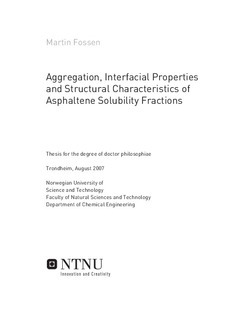| dc.contributor.author | Fossen, Martin | nb_NO |
| dc.date.accessioned | 2014-12-19T13:22:47Z | |
| dc.date.available | 2014-12-19T13:22:47Z | |
| dc.date.created | 2007-10-26 | nb_NO |
| dc.date.issued | 2007 | nb_NO |
| dc.identifier | 122885 | nb_NO |
| dc.identifier.isbn | 978-82-471-3473-3 | nb_NO |
| dc.identifier.uri | http://hdl.handle.net/11250/248062 | |
| dc.description.abstract | Crude oil is the primary source for energy in the world and serves as the raw material for many daily products. Two topics, important in the daily processing of crude oils, are treated in this thesis. Water-in-oil emulsions must be broken to obtain the desired quality of the crude oil delivered to the refineries with respect to water and salt content and asphaltenes are of concern at all stages of the recovery, transportation and processing of crude oils. The work has been of experimental nature and the results are reported in journal papers and manuscripts.
A lab-scale continuous separation rig was constructed and later equipped with a compact electro coalescer. The results show that water cut and pressure drop affect the droplet size distribution of water-in-oil emulsions. Moreover, two demulsifiers were tested on crude oil emulsions under high electric fields. The study indicated that it is not trivial which type of demulsifier to choose when an electric field is applied in combination with chemical destabilization.
Hansen solubility parameters for solvents and binary mixtures were correlated to infrared and near infrared spectra by partial least squares regression. Regression coefficients and errors of validation indicated that the regressions and predictions were good. The models were used to predict solubility parameters for crude oils and SARA fractions and the values obtained were in range of what has been reported in the literature.
Asphaltenes were separated into several solubility fractions directly from the crude oil by stepwise addition and precipitation by n-pentane. The solubility fractions had very different properties with regard to aggregation onset and interfacial activity which to a certain degree were explained by the differences found in the average size and molecular structures of the fractions. It was shown that the less soluble fractions consisted of molecules with larger average molecular weight, higher aromaticity and more polar aromatic cores. For the more soluble fractions results indicated that the substituted alkyl side chains on the aromatic cores were more branched and contained more of the hydroxylic and carboxylic groups, which again could explain the higher interfacial activity. Experiments also suggested that neither the least nor the most soluble of the asphaltenes under investigation were the ones with the highest interfacial activity, but a middle fraction. The findings suggest the need for looking into solubility fractions of asphaltene in further research and compare with the asphaltenes found in deposits or obtained from pressure drop experiments. | nb_NO |
| dc.language | eng | nb_NO |
| dc.publisher | Fakultet for naturvitenskap og teknologi | nb_NO |
| dc.relation.ispartofseries | Doktoravhandlinger ved NTNU, 1503-8181; 2007:158 | nb_NO |
| dc.relation.haspart | Fossen, Martin; Hemmingsen, Pål Viggo; Hannisdal, Andreas; Sjöblom, Johan; Kallevik, Harald. Solubility Parameters Based on IR and NIR Spectra: I. Correlation to Polar Solutes and Binary Systems. Journal of Dispersion Science and Technology. 26(2): 227-241, 2005. | nb_NO |
| dc.relation.haspart | Fossen, Martin; Kallevik, Harald; Knudsen, Kenneth D.; Sjöblom, Johan. Asphaltenes Precipitated by a Two-Step Precipitation Procedure. Energy & Fuels. 21(2): 1030-1037, 2007. | nb_NO |
| dc.relation.haspart | Fossen, Martin; Sjöblom, Johan; Kallevik, Harald; Jakobsson, Joakim. A New Procedure for Direct Precipitation and Fractionation of Asphaltenes from Crude Oil. Journal of Dispersion Science and Technology. 28(1): 193-197, 2007. | nb_NO |
| dc.relation.haspart | Fossen, Martin; Arntzen, Richard; Hemmingsen, Pål Viggo; Jakobsson, Joakim; Sjöblom, Johan. A Laboratory-Scale Vertical Gravity Separator for Emulsion Characterization. Journal of Dispersion Science and Technology. 27(4): 453-461, 2006. | nb_NO |
| dc.title | Aggregation, interfacial properties and structural characteristics of asphaltene solubility fractions | nb_NO |
| dc.type | Doctoral thesis | nb_NO |
| dc.contributor.department | Norges teknisk-naturvitenskapelige universitet, Fakultet for naturvitenskap og teknologi, Institutt for kjemisk prosessteknologi | nb_NO |
| dc.description.degree | PhD i kjemisk prosessteknologi | nb_NO |
| dc.description.degree | PhD in Chemical Process Engineering | en_GB |
